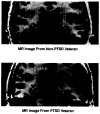Magnetic resonance imaging study of hippocampal volume in chronic, combat-related posttraumatic stress disorder
- PMID: 8931911
- PMCID: PMC2910907
- DOI: 10.1016/S0006-3223(96)00229-6
Magnetic resonance imaging study of hippocampal volume in chronic, combat-related posttraumatic stress disorder
Abstract
This study used quantitative volumetric magnetic resonance imaging techniques to explore the neuroanatomic correlates of chronic, combat-related posttraumatic stress disorder (PTSD) in seven Vietnam veterans with PTSD compared with seven nonPTSD combat veterans and eight normal nonveterans. Both left and right hippocampi were significantly smaller in the PTSD subjects compared to the Combat Control and Normal subjects, even after adjusting for age, whole brain volume, and lifetime alcohol consumption. There were no statistically significant group differences in intracranial cavity, whole brain, ventricles, ventricle:brain ratio, or amygdala. Subarachnoidal cerebrospinal fluid was increased in both veteran groups. Our finding of decreased hippocampal volume in PTSD subjects is consistent with results of other investigations which utilized only trauma-unexposed control groups. Hippocampal volume was directly correlated with combat exposure, which suggests that traumatic stress may damage the hippocampus. Alternatively, smaller hippocampi volume may be a pre-existing risk factor for combat exposure and/or the development of PTSD upon combat exposure.
Figures
Similar articles
-
Amygdala volume changes in posttraumatic stress disorder in a large case-controlled veterans group.Arch Gen Psychiatry. 2012 Nov;69(11):1169-78. doi: 10.1001/archgenpsychiatry.2012.50. Arch Gen Psychiatry. 2012. PMID: 23117638 Free PMC article.
-
Amygdala volume in combat-exposed veterans with and without posttraumatic stress disorder: a cross-sectional study.Arch Gen Psychiatry. 2012 Oct;69(10):1080-6. doi: 10.1001/archgenpsychiatry.2012.73. Arch Gen Psychiatry. 2012. PMID: 23026958
-
The relationship between hippocampal volume and declarative memory in a population of combat veterans with and without PTSD.Ann N Y Acad Sci. 2006 Jul;1071:405-9. doi: 10.1196/annals.1364.031. Ann N Y Acad Sci. 2006. PMID: 16891587
-
Hippocampal volume deficits associated with exposure to psychological trauma and posttraumatic stress disorder in adults: a meta-analysis.Prog Neuropsychopharmacol Biol Psychiatry. 2010 Oct 1;34(7):1181-8. doi: 10.1016/j.pnpbp.2010.06.016. Epub 2010 Jun 21. Prog Neuropsychopharmacol Biol Psychiatry. 2010. PMID: 20600466 Review.
-
Hippocampal volume in borderline personality disorder with and without comorbid posttraumatic stress disorder: a meta-analysis.Eur Psychiatry. 2011 Oct;26(7):452-6. doi: 10.1016/j.eurpsy.2010.07.005. Epub 2010 Oct 8. Eur Psychiatry. 2011. PMID: 20933369
Cited by
-
The brain on stress: Insight from studies using the Visible Burrow System.Physiol Behav. 2015 Jul 1;146:47-56. doi: 10.1016/j.physbeh.2015.04.015. Physiol Behav. 2015. PMID: 26066722 Free PMC article. Review.
-
Prospective reports of chronic life stress predict decreased grey matter volume in the hippocampus.Neuroimage. 2007 Apr 1;35(2):795-803. doi: 10.1016/j.neuroimage.2006.10.045. Epub 2007 Feb 1. Neuroimage. 2007. PMID: 17275340 Free PMC article.
-
Influence of post-traumatic stress disorder on neuroinflammation and cell proliferation in a rat model of traumatic brain injury.PLoS One. 2013 Dec 9;8(12):e81585. doi: 10.1371/journal.pone.0081585. eCollection 2013. PLoS One. 2013. PMID: 24349091 Free PMC article.
-
Volumetric analysis of amygdala, hippocampus, and prefrontal cortex in therapy-naive PTSD participants.Biomed Res Int. 2014;2014:968495. doi: 10.1155/2014/968495. Epub 2014 Mar 13. Biomed Res Int. 2014. PMID: 24745028 Free PMC article.
-
Chronic stress alters synaptic terminal structure in hippocampus.Proc Natl Acad Sci U S A. 1997 Dec 9;94(25):14002-8. doi: 10.1073/pnas.94.25.14002. Proc Natl Acad Sci U S A. 1997. PMID: 9391142 Free PMC article.
References
-
- Axelson DA, Doraiswamy PM, McDonald WM, Boyko OB, Tupler LA, Patterson LJ, Nemeroff CB, Ellinwood EH, Krishna KRR. Hypercortisolemia and hippocampal changes in depression. Psychiatry Res. 1993;47:163–173. - PubMed
-
- Baydena L, Branchey MH, Noumair D. Age of alcoholism onset I: Relationship to psychopathology. Arch Gen Psychiatry. 1989;46:225–230. - PubMed
-
- Benton AB. Benton Visual Retention Test. 5. San Antonio: Harcourt Brace Jovanovich, Inc. (The Psychological Corporation); 1992.
-
- Blake DD, Weathers FW, Nagy LM, Kaloupek DG, Gusman FD, Charney DS, Keane TM. The development of a clinician-administered PTSD scale. J Traumatic Stress. 1995;8:75–90. - PubMed
-
- Bogerts B, Lieberman JA, Ashtari M, Bilder RM, Degreef G, Lerner G, Johns C, Masiar S. Hippocampus-amygdala volumes and psychopathology in chronic schizophrenia. Biol Psychiatry. 1993;33:236–246. - PubMed
Publication types
MeSH terms
Grants and funding
LinkOut - more resources
Full Text Sources
Other Literature Sources
Medical



